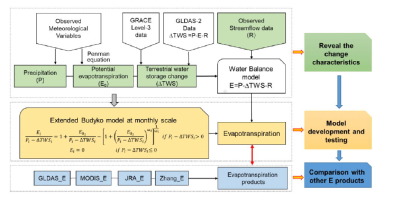当前位置:
X-MOL 学术
›
J. Hydrol.
›
论文详情
Our official English website, www.x-mol.net, welcomes your
feedback! (Note: you will need to create a separate account there.)
Estimating monthly evapotranspiration by assimilating remotely sensed water storage data into the extended Budyko framework across different climatic regions
Journal of Hydrology ( IF 5.9 ) Pub Date : 2018-12-01 , DOI: 10.1016/j.jhydrol.2018.10.014 Wanqiu Xing , Weiguang Wang , Quanxi Shao , Bin Yong , Catherine Liu , Xiaozhou Feng , Qing Dong
Journal of Hydrology ( IF 5.9 ) Pub Date : 2018-12-01 , DOI: 10.1016/j.jhydrol.2018.10.014 Wanqiu Xing , Weiguang Wang , Quanxi Shao , Bin Yong , Catherine Liu , Xiaozhou Feng , Qing Dong

|
Abstract The estimates of actual evapotranspiration (E) across basins and/or regions are still facing some difficulties because of the complex interactions amongst the components of the land-plant-atmosphere system, even though the basic physical mechanism of E is well understood. Presenting as a nonlinear relationship constrained by physical limits, the Budyko framework serves as a powerful tool used to estimate the averaged E at long-term scale. Given the ability of Gravity Recovery And Climate Experiment (GRACE) in effectively simulating the terrestrial water storage change (ΔTWS) at monthly scale, a model to estimate E was developed based on the Budyko framework with mean monthly parameter of multi-years, and was applied to the estimation of E for the 24 selected catchments in different climatic regions across China. Results indicate that for the majority of 24 catchments, the positive or negative trends in precipitation (P), potential evapotranspiration (E0), runoff (R) and ΔTWS were not statistically significant during 2003–2013 at both annual and monthly scales, but the ΔTWS occupied a large proportion in the partitioning of P into R and E at monthly scale. The monthly Budyko parameter showed large variation within the year and also across these 24 catchments. The Budyko-modeled monthly E (Budyko-E) represented the GRACE-derived ones (GRACE-E) across these catchments well with both modeled E volumes and hydrograph shapes which were also consistent with GRACE-E series except some underestimation for peak E. Overall, the Budyko-E represented GRACE-E in the arid and semi-arid catchments comparatively better than it in the humid and semi-humid catchments due to the larger proportion of ΔTWS in the P partition. Among all the 24 selected catchments, the monthly Budyko-type E model represented the GRACE-E across Shixiali catchment (located in the Hai River basin) best, with the correlation coefficient (r), Nash-Sutcliffe coefficient (NSCE) and relative error (RE) between GRACE-E and simulated results being 0.996, 0.988, −0.033 in calibration and 0.994, 0.951, −0.111 in validation, respectively. Furthermore, using GRACE-E as the benchmark values, the Budyko-E outperformed four other global E products from the newly published Global Land Data Assimilation System with Noah Land Surface Model-2 (GLDAS_E), MODIS (MODIS_E), Japanese 25-year reanalysis product (JRA_E), and Zhang’s method (Zhang_E). GLDAS_E was the best of four global E products at reproducing monthly variations, with relatively high r and NSCE values, small RE. While MODIS_E showed the poorest performance in reproducing the inter-annual E variations of these catchments, which was reflected by low r and NSCE values. This extended Budyko-E model can apply in other similar climatic regions and also may provide skill in evaluating the water resources since the preferable accuracy of E estimate.
更新日期:2018-12-01











































 京公网安备 11010802027423号
京公网安备 11010802027423号